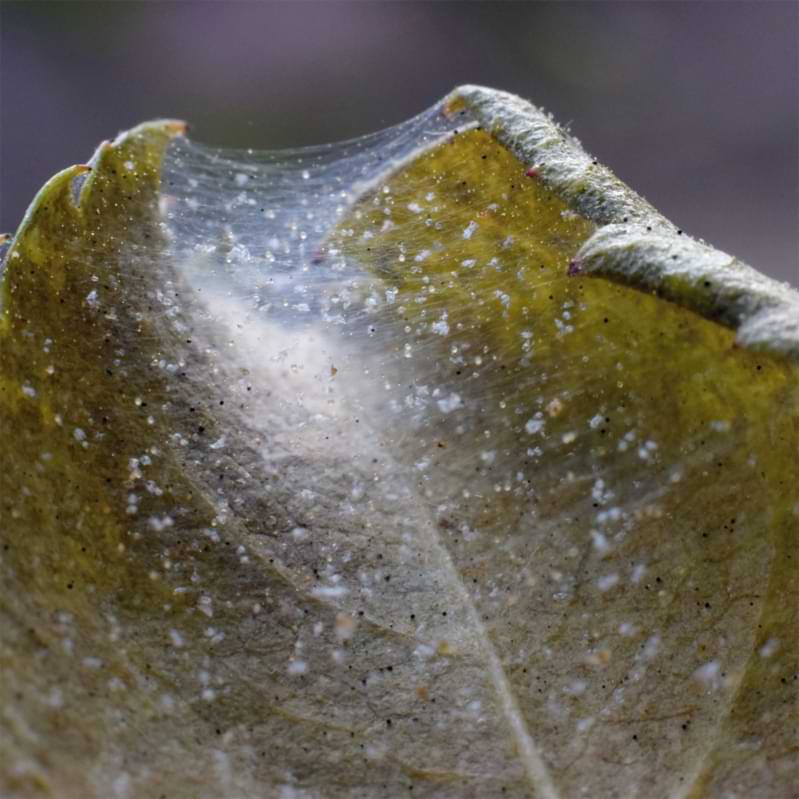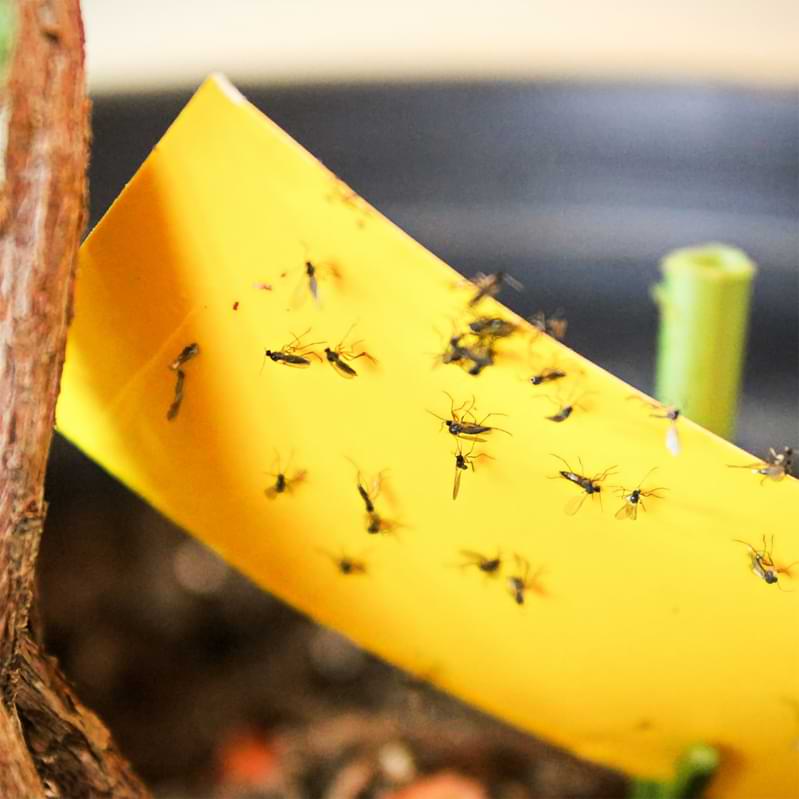A basic knowledge of houseplant insect control is crucial for indoor plant owners, because at some point, you’re going to have to deal with pest problems. It’s just an inevitable part of being a plant parent.
However, there are ways to ward off pests before they become a problem. A little prevention goes a long way here!
In this article, I’ll go through the best methods for preventing insect problems, the most common household pests to watch for, how to know when your plant has an infestation, and how to get rid of those pests when they show up.
First, prevention.
Table of Contents
The Golden Rule of Houseplant Insect Control: Prevention
Preventing insect infestations will save you a LOT of houseplant headaches down the road.
The key is to keep pests out of your home as much as possible, and create conditions that don’t allow for pests to thrive, lay eggs, and spread.
Here are a few keys to discourage all household pests:
1. Inspect plants before buying.
If you buy your plant in person from a store, give it a once-over first.
Look for telltale signs of insects like small brown or red spots on the leaves, small holes, webbing, sticky clear residue (this is called “honeydew”), and actual insects, of course. If you see anything, try a different plant, or even a different store.
2. Quarantine all new plants.
Insects can spread from plant to plant, and unfortunately, this happens a lot in greenhouses and garden centers, which means you might bring home a buggy plant.
When you bring home a new houseplant (or when it arrives in the mail from an online seller), try to keep it away from other plants for a couple weeks if possible. This will give any insect issues a chance to manifest so you can deal with them before they infect your other houseplants.
3. Provide proper watering and light conditions.
In general, most household pests thrive in dark, damp conditions. So create the opposite!
Be very careful not to overwater your plants (I suggest using a moisture meter to help you dial in your watering routine) and make sure your plants get the right amount of sunlight so they can use water efficiently.
It’s also important to maintain proper pot and soil drainage. Always use pots that drain well, and keep a close eye on the soil. If you notice the soil getting compacted, use a chopstick to aerate it or repot the plant and switch out the soil.
4. Use Leaf Armor
Our houseplant Leaf Armor spray protects your plants’ leaves from pests as well as dust, debris, hard water, bacteria, and fungus. Spray your plant down regularly to prevent pests and keep your leaves healthy and glossy!
You can buy Leaf Armor on Amazon.
Signs That Your Houseplants Have a Pest Problem
It’s also important to know the signs that your houseplants may have been invaded by insects because if you can catch the problem early, it’s much easier to treat!
Here are some common signs to watch out for:
1. Small brown or red spots on the leaves
Many insects suck juices out of the leaves, leaving behind little reddish-brown dots, especially on new growth.
If you notice this happening, take a closer look at your plant’s leaves (both sides), stems, and soil. Use a magnifying glass if you have one, because many pests can be too small to see with the naked eye.
If you see anything, skip to the section below to ID and eliminate the pest!
2. Small holes
Some pests eat little holes in the leaves, so this is a common sign that something is up. Inspect the plant closely and skip to the treatment section if you see insects!

3. Webbing
If you notice cottony, fluffy webbing on the leaves or stems, you’ve got a pest problem. Make sure to nip it in the bud early!
4. Honeydew
Some pests leave behind a clear, sticky goo on the leaves. If you see this on your plant, act fast! Not only is it a sign that you already have a pest problem, but it can attract even more insects like gnats, ants, and flies.

5. Actual insects
Some insects, like fungus gnats, are pretty bold and will fly around your houseplant like they own the place. If you notice tiny flying insects, brown or white scaly bumps, or little insects crawling all over your plant, it’s time to take action.
Houseplant Insect Control in Action: How to Treat Pest Problems
The sooner you catch and treat insect problems, the better. If left untreated, insects can kill your plant and spread to other houseplants in your home. If you act quickly, you’ll have a better chance of wiping out the pests and saving your plants!
Here are the most common household pests to watch out for and how to get rid of them:
1. Spider mites
These little guys like to suck the juices out of your plant’s leaves and leave behind clusters of those little brown dots we mentioned earlier. If you have a spider mite problem, you’ll also notice webbing on the leaves in long, thin strands. The actual insects are very tiny, so you may need a magnifying glass to actually see them.
Luckily, spider mites are fairly easy to get rid of. Simply give your plant a shower! Rinse it in the shower or sink with tepid water, or take it outside and spray it off with the hose. If the infestation is mild, you can also squirt the little buggers off with a kitchen syringe full of water (or a water gun, if you’re feeling feisty).
Spray your plant down with Leaf Armor to keep spider mites away.
If you can’t seem to get rid of them completely, get out the big guns and treat your plant with neem oil, which you can order online or buy at any gardening store. Make sure to do this outside or somewhere well-ventilated, because it’s a bit smelly. Follow the instructions on the bottle to ensure that you dilute it properly, or you’ll chemically burn your plant’s leaves!
2. Scale
Most species of scale look like small brown or white bumps stuck on the leaves and stems of your plants. They suck the sap out of your plant and leave behind that sticky honeydew that can attract even MORE insects.
These guys stick on pretty hard, so the best way to remove them is to use your fingernails or a toothpick to pry them off. If you have a few leaves that are heavily infested, you may be better off removing those altogether.
3. Mealybugs
These are technically a species of scale, but they don’t have the same hard shell that makes most other species so hard to remove. We tend to treat this as a separate pest.
These soft-bodied insects produce fluffy webbing and honeydew, and they look like little white balls.
To treat a mealybug infestation, try showering the plant first like you would for spider mites. If you notice the issue reoccurring, dab each visible insect and wad of cotton fluff (these are nests) with a little rubbing alcohol on a cotton swab to kill them.
You may also want to spray down your plant with diluted neem oil or Leaf Armor to discourage the mealybugs from returning. (Are you noticing a theme here? Neem oil and Leaf Armor are great all-purpose insecticides for household pests, especially ones that won’t be discouraged by showering.)
4. Fungus gnats
Fungus gnats lay their eggs in the top few inches of soil and buzz around your plants. Annoying!
The best way to prevent and get rid of them is to let the top few inches of soil dry out before watering, since these insects thrive in dark, damp conditions.
You can also carefully scoop out the top few inches of soil and replace it with fresh potting mix. Sprinkle the surface with a little cinnamon to discourage them further (this also prevents fungal growth in the soil—bonus!).
To trap existing gnats, make a trap by putting a few drops of apple cider vinegar in a small container, covering the top with plastic wrap, and poking a few holes in the plastic. Set this trap at the base of your plants. When the gnats fly in through the holes to get to the vinegar, they won’t be able to get back out!
Leaf Armor: Your Secret Weapon for Houseplant Insect Control
We’ve mentioned Leaf Armor a few times in this article, and that’s because I LOVE it for keeping my houseplants healthy and beautiful! I spray my plants with it every few weeks to protect the leaves from insects, bacteria, and other nasty stuff that can hurt my plants, and it’s also great for treating existing insect problems. Give it a try!
Read our other guides for treating common houseplant problems:
7 Signs You’re Over-Fertilizing Your Houseplant and How to Fix It




